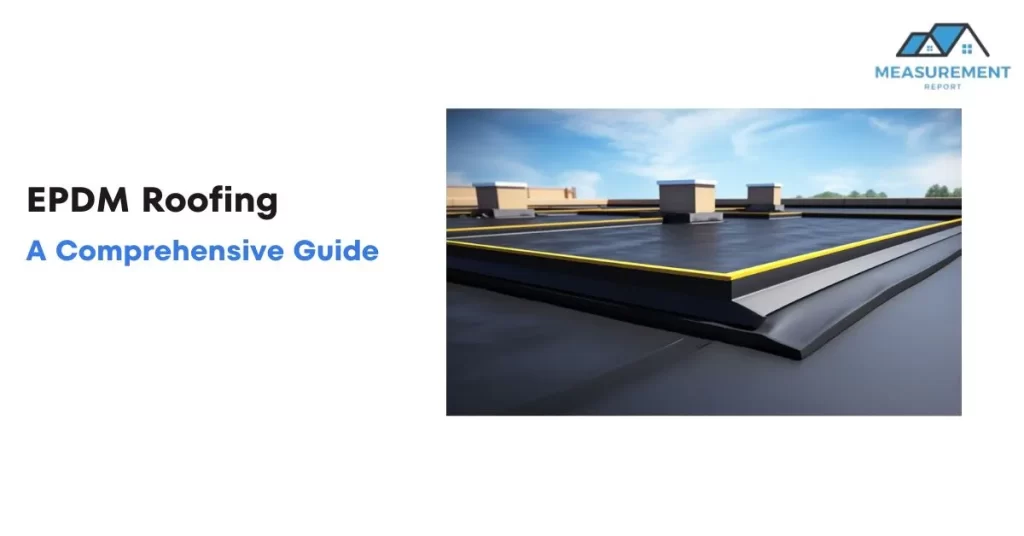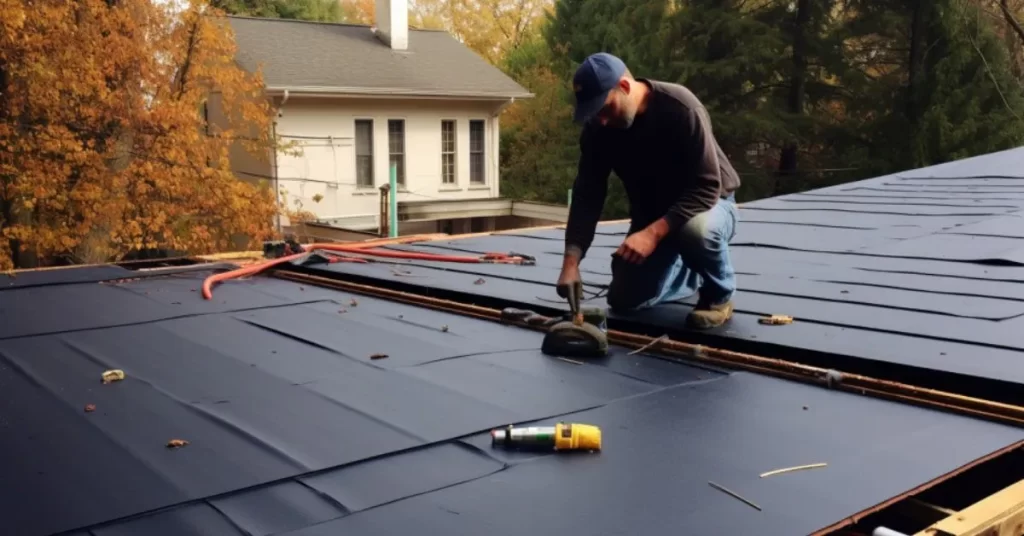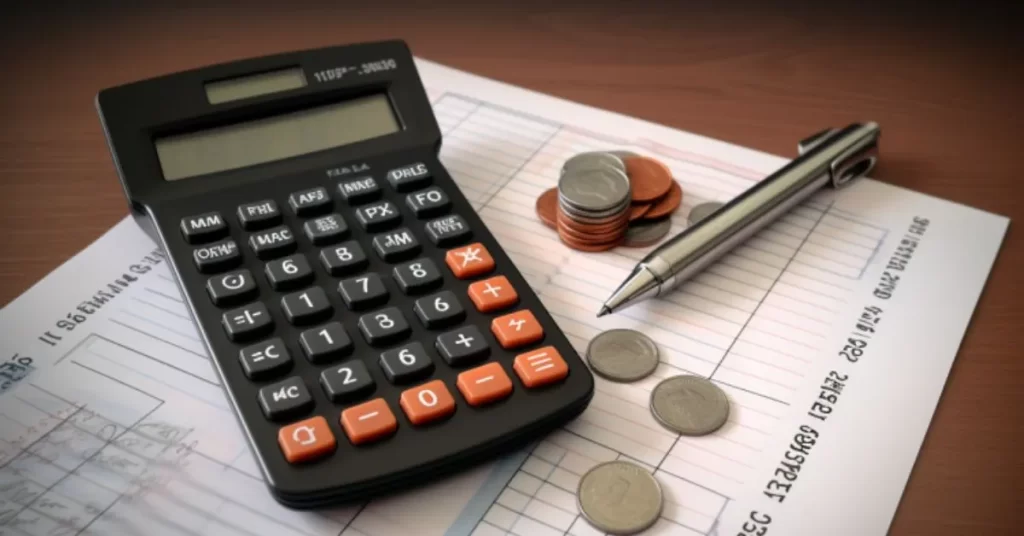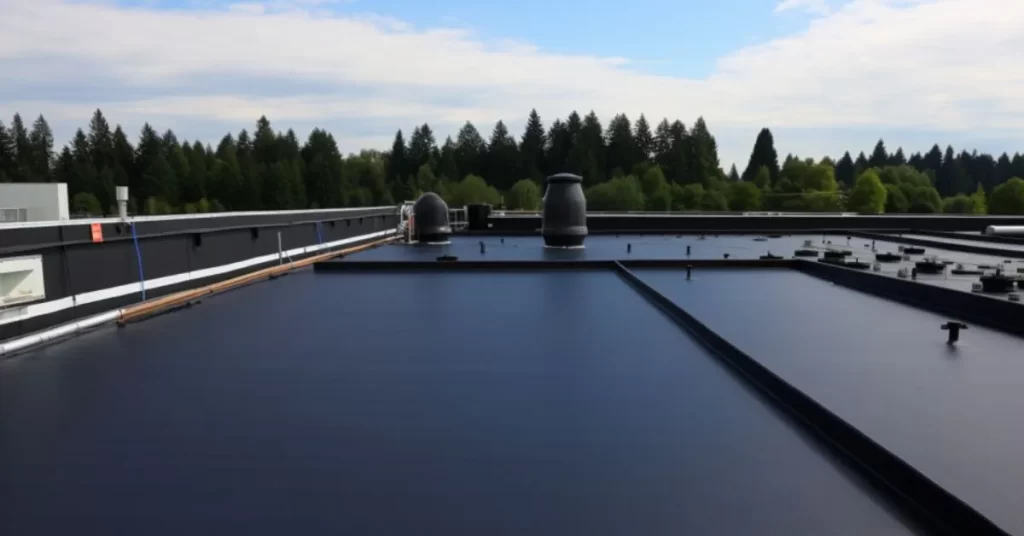EPDM Roofing Guide: Installation, Benefits, and Costs

EPDM (Ethylene Propylene Diene Monomer) roofing stands as a pinnacle of modern roofing technology, epitomizing durability and versatility in a way few materials can. As a synthetic rubber roofing membrane widely recognized for its remarkable resilience, EPDM roofing has become a staple in both residential and commercial construction. Renowned for its long lifespan and ability to withstand a variety of environmental stressors, this roofing material has carved a significant niche in the construction world.
In the realm of contemporary building and renovation, the choice of roofing material is pivotal. EPDM, with its unique composition and features, offers an appealing option for those looking to combine longevity with performance. This article delves deep into the world of EPDM roofing, offering a thorough exploration of its installation processes, highlighting the multitude of benefits it brings to the table, and breaking down the cost implications. Whether you’re a homeowner considering a roofing upgrade, a professional in the construction field, or simply someone intrigued by the advancements in building materials, this guide aims to equip you with a comprehensive understanding of EPDM roofing and its significant role in modern construction.
What is EPDM Roofing Material
EPDM roofing material, a type of synthetic rubber, is a standout choice in the vast landscape of roofing options. This material, known fully as Ethylene Propylene Diene Monomer, is particularly lauded for its durability, weather resistance, and versatility. Its composition, primarily derived from oil and natural gas byproducts, results in a membrane that is both flexible and strong, making it an ideal candidate for protecting buildings from the elements.
Delving into the characteristics of EPDM, its resilience against UV radiation, extreme temperatures, and even acid rain sets it apart. The material is designed to expand and contract with temperature changes, preventing cracks and leaks that are common in less flexible materials. Additionally, its dark color aids in heat absorption, which can be beneficial in cooler climates.
The journey of EPDM roofing through history is a tale of innovation and adaptation. First introduced in the 1960s, it quickly gained traction as an alternative to traditional materials like felt and asphalt. Over the decades, advancements in technology and manufacturing have only enhanced its qualities, solidifying its position as a reliable choice for roofing.
EPDM’s adaptability extends to its applications, finding a home on a variety of roof types, but it shines particularly bright in commercial and flat roof scenarios. Its ability to cover large areas seamlessly makes it a favorite in commercial projects, where minimizing leaks and maintenance is crucial. Moreover, for flat roofs, which are prone to water pooling and require extra protection, the water-resistant nature of EPDM makes it an invaluable asset. As highlighted in our comprehensive guide on TPO Roofing, another popular flat roofing option, the choice of material can make a significant difference in both performance and longevity.
Whether it’s a sprawling commercial complex or a residential building with a flat roof, EPDM stands as a testament to the evolution and advancement in roofing materials, offering a solution that balances efficiency, cost-effectiveness, and durability.
EPDM Roofing Installation Steps

The installation of EPDM roofing, a process requiring precision and expertise, is a critical stage in ensuring the longevity and effectiveness of this roofing material. The journey from rolls of synthetic rubber to a fully functional roof involves several meticulous steps, each playing a pivotal role in the overall performance of the roofing system.
Surface Preparation
Before the actual installation of the EPDM membrane begins, it’s crucial to prepare the roof surface thoroughly. This involves cleaning the substrate to remove any debris, dust, or existing material that might compromise the adhesion or integrity of the EPDM. It’s also important to ensure the surface is dry and smooth, as moisture and irregularities can lead to issues post-installation.
Installation Techniques
There are three primary techniques for installing EPDM roofing: fully adhered, mechanically attached, and ballasted.
- Fully Adhered: In this method, the EPDM membrane is glued directly to the substrate using a special adhesive. This technique provides a smooth, uniform appearance and is ideal for roofs with irregular shapes or multiple penetrations.
- Mechanically Attached: This method involves fastening the EPDM sheets to the roof deck with mechanical fasteners. It’s a quicker and more cost-effective method compared to the fully adhered system, suitable for large, open roof areas.
- Ballasted: Here, the EPDM membrane is laid loose over the roof substrate and held in place with a ballast, typically stones or pavers. This method is quick and easy, making it a popular choice for large commercial buildings.
Common Installation Mistakes to Avoid
Mistakes during installation can significantly reduce the effectiveness and lifespan of an EPDM roof. Common errors include:
- Inadequate cleaning and preparation of the substrate.
- Improper application of adhesive, leading to blisters and leaks.
- Insufficient sealing at seams and edges, which are critical areas for preventing water ingress.
- Not allowing for enough expansion and contraction in the material, especially in varying climates.
DIY Tips for EPDM Roofing
While professional installation is recommended for optimal results, DIY enthusiasts can undertake EPDM roofing projects with the right tools and knowledge. Key tips include:
- Conduct thorough research and planning before beginning the project.
- Use quality materials and follow manufacturer guidelines for adhesives and sealants.
- Pay special attention to detail around edges, seams, and areas where the roof meets other structures like chimneys or vents.
For those considering a DIY approach, understanding the intricacies of roof flashing, as detailed in our Roof Flashing Guide, can be immensely beneficial. Additionally, referring to resources like our DIY Roof Sheathing Guide can provide valuable insights into the broader aspects of roofing.
Benefits of EPDM Roofing
The benefits of EPDM roofing extend far beyond its immediate functionality as a protective layer for buildings. This roofing material stands out for its exceptional durability, environmental friendliness, and energy efficiency, making it a top choice for both new constructions and renovations.
Durability and Longevity
One of the most significant advantages of EPDM roofing is its remarkable lifespan. With proper installation and maintenance, an EPDM roof can last up to 50 years, a testament to its durability. This longevity stems from the material’s resistance to weathering, UV radiation, extreme temperatures, and even abrasion. Unlike many other roofing materials, EPDM maintains its integrity and flexibility over time, reducing the likelihood of cracks and leaks. This extended lifespan not only provides peace of mind but also translates into cost savings in the long run, as the need for frequent replacements is significantly diminished.
Environmental Aspects
In today’s eco-conscious world, the environmental impact of building materials is a critical consideration. EPDM roofing scores high in this regard due to several factors. First, it is made from recycled materials, reducing the demand for new raw resources. Secondly, at the end of its life, EPDM can be recycled again, ensuring minimal environmental footprint. This cycle of reuse aligns well with modern sustainability practices, making EPDM an environmentally responsible choice for roofing.
Furthermore, the production process of EPDM has a lower environmental impact compared to other synthetic materials, and its lightweight nature means reduced energy consumption during transportation and installation. For those interested in sustainable building practices, further insights can be gained from our article on Ice and Water Shield Roofing, another eco-friendly roofing solution.
Energy Efficiency Benefits
EPDM roofing contributes significantly to energy efficiency in buildings. Its inherent thermal properties help in regulating indoor temperatures. In cooler climates, the dark color of traditional EPDM absorbs heat, reducing the need for heating. Conversely, the material can also be treated to reflect sunlight, thereby keeping buildings cooler in warmer climates and cutting down on air conditioning costs.
This aspect of EPDM roofing not only aids in reducing energy bills but also plays a role in reducing the carbon footprint of buildings. By optimizing energy use, EPDM roofing aligns with the growing trend towards energy-efficient building designs. For a deeper understanding of how roofing materials impact energy use, readers can explore our comprehensive guide on Roof Measurement using Drone Technology, which highlights the latest advancements in efficient roofing practices.
Maintenance Tips for EPDM Roofing
The longevity and performance of an EPDM roof are heavily contingent on regular maintenance and the adept handling of any repairs that may arise. Understanding the nuances of maintaining and repairing EPDM roofing can significantly extend its lifespan and ensure it continues to function effectively.
Maintenance Tips for EPDM Roofing
Regular maintenance is key to prolonging the life of an EPDM roof. The following tips are essential for maintaining its condition:
- Routine Inspections: Conduct bi-annual inspections, ideally in the spring and fall, to check for signs of wear, such as cracks or loosening seams. Also, inspect after major weather events.
- Debris Clearance: Remove debris like leaves, twigs, and dirt that accumulates on the roof. This prevents blockage in drainage systems and reduces the risk of pooling water.
- Surface Cleaning: Use a mild soap and water solution to clean the surface of the roof. Avoid harsh chemicals that can deteriorate the EPDM material.
- Seam Maintenance: Regularly check the seams and edges of the roofing material. If they begin to come apart, use a seam primer and seam tape or liquid adhesive to reseal them.
- Drainage Check: Ensure that gutters and drains are clear of obstructions to prevent water accumulation.
For more in-depth information on roof upkeep, readers may find our Roof Maintenance Guide useful, as it covers a broader spectrum of roofing materials and their specific care requirements.
Repairing EPDM Roofs
Even with diligent maintenance, repairs may be necessary over time. The process for repairing EPDM roofing is relatively straightforward:
- Identify the Issue: Common problems include small punctures, tears, or seam separations. Locating the problem area is the first step in the repair process.
- Prepare the Area: Clean the area around the damage thoroughly before proceeding with the repair.
- Patch and Seal: Use an EPDM patch and roofing adhesive to cover and seal any punctures or tears. For seams, apply seam tape or adhesive as appropriate.
- Professional Assessment: For larger or more complex issues, consulting with a professional roofing contractor is advisable.
Common Problems and Solutions
Some typical issues encountered with EPDM roofing include:
- Ponding Water: Ensure proper drainage to avoid water pooling, which can deteriorate the roof over time.
- Shrinkage: EPDM can shrink with age, pulling away from edges and flashing. Regular inspections can catch this early, and repairs can be made with additional material or adhesive.
- Membrane Punctures: Minor punctures can be easily repaired with a patch kit, but larger damages might require professional intervention.
In cases where roof damage might be linked to external factors like extreme weather, it’s prudent to explore options for insurance coverage. Our guide on How to Get Insurance to Pay for Roof Replacement offers valuable insights into navigating insurance claims for roofing repairs.
Cost of Installation and Factors Influencing

When considering EPDM roofing for a construction project, an essential aspect to delve into is the cost analysis. Understanding the financial implications of installing an EPDM roof helps in making an informed decision, especially when budget constraints are a concern.
Cost of Installation and Factors Influencing It
The cost of EPDM roofing installation can vary significantly based on several factors. On average, the price ranges from $3.50 to $7.00 per square foot, but this can fluctuate depending on:
- Roof Size and Complexity: Larger roofs require more material, which increases the cost. The complexity of the roof design, such as the presence of multiple levels or a high number of penetrations (like vents or chimneys), can also affect the price.
- Material Quality: The thickness and quality of the EPDM membrane impact the cost. Thicker membranes offer better durability but are more expensive.
- Installation Method: The chosen installation technique (fully adhered, mechanically attached, or ballasted) influences the overall cost. Fully adhered systems tend to be more expensive due to the additional labor and materials required.
- Geographic Location: Labor costs vary by region, which can affect the total installation cost.
- Additional Features: The inclusion of insulation, vapor barriers, or specialized coatings can also increase the price.
For a detailed breakdown of costs and materials, readers may refer to our Commercial Roof Measurement Guide, which provides insights into various aspects of roofing projects.
Affordable EPDM Roofing Options
Despite the factors that can elevate the cost of EPDM roofing, there are ways to make it more affordable:
- Choose Standard Thickness: Opting for the standard thickness instead of the premium options can reduce costs without significantly impacting performance.
- Simplified Installation: Selecting a simpler installation method, like a ballasted system, can be more cost-effective.
- Bulk Purchasing: For large projects, buying materials in bulk can lead to discounts.
- DIY Installation: For smaller projects or outbuildings, a DIY approach can save on labor costs. However, this should only be considered if you have the necessary skills and experience.
- Regular Maintenance: Investing in regular maintenance can prevent costly repairs and extend the life of the roof, leading to long-term savings.
It’s important to remember that while seeking affordable options, compromising on the quality of materials or installation can lead to increased costs in the long run due to repairs and replacements. As emphasized in our guide on The Best Materials for a Flat Roof, the choice of materials plays a crucial role in the overall performance and longevity of the roof.
Comparisons with Other Roofing Materials
When selecting a roofing material, it’s crucial to weigh the options available. EPDM roofing, with its unique properties, often finds itself compared to other popular materials like TPO, PVC, and asphalt shingles. Understanding the differences, along with the pros and cons of each, can guide homeowners and contractors in making the best choice for their specific needs.
EPDM vs. TPO
Both EPDM and TPO (Thermoplastic Olefin) are commonly used in low-slope and flat roofs, particularly in commercial buildings.
- EPDM: Known for its exceptional longevity (up to 50 years) and durability. It’s more flexible, making it resistant to punctures and tears. However, EPDM is generally black, which can absorb more heat unless treated with a reflective coating.
- TPO: Offers better energy efficiency due to its reflective surface, which helps in reducing cooling costs. It’s also relatively faster to install. The downside is that TPO can be less resistant to punctures and may have a shorter lifespan compared to EPDM.
For a more in-depth comparison, our guide on TPO Roofing offers extensive insights.
EPDM vs. PVC
PVC (Polyvinyl Chloride) roofing is another synthetic roofing membrane popular for its durability and energy efficiency.
- EPDM: It is more affordable than PVC and offers superior resistance to weathering and UV radiation. However, EPDM is not as resistant to chemicals as PVC.
- PVC: This material is highly resistant to chemical exposure and is more fire-resistant than EPDM. PVC roofs are also more energy-efficient due to their lighter colors but tend to be more expensive.
EPDM vs. Asphalt Shingles
Asphalt shingles are widely used in residential roofing due to their cost-effectiveness and ease of installation.
- EPDM: Offers a much longer lifespan and is more durable in extreme weather conditions. It is also more environmentally friendly, as it’s recyclable.
- Asphalt Shingles: They are more aesthetically versatile and can be a better fit for steep-slope roofs. However, they don’t match the durability of EPDM and can be more prone to damage from high winds and hail.
Pros and Cons
- Pros of EPDM: Longevity, flexibility, resistance to UV rays and extreme temperatures, and eco-friendliness.
- Cons of EPDM: Standard EPDM absorbs heat (unless treated), requires professional installation, and can be less aesthetically pleasing than other options.
While EPDM roofing stands out for its durability and environmental benefits, factors such as aesthetic preferences, budget, and specific roof requirements play a crucial role in deciding the most suitable material. For further comparisons and detailed guides on various roofing materials, readers can explore our extensive collection of articles, including our Slate Roofing Guide for another perspective on roofing solutions.
Long-Term Value and Sustainability
When investing in an EPDM roofing system, understanding the warranties and long-term considerations is crucial for maximizing value and ensuring sustainable practices.
Available Warranties for EPDM Roofing
Most EPDM roofing manufacturers offer warranties, which can range from 10 to 30 years, covering aspects like material defects and, in some cases, installation errors. The specifics of these warranties vary, with some offering pro-rata coverage that decreases over time. It’s important to read the fine print and understand what is covered, including any potential labor costs for repairs. High-quality EPDM membranes often come with more comprehensive warranties, reflecting the manufacturer’s confidence in their product’s longevity and performance.
Long-Term Value and Sustainability
EPDM roofing is not just a cost-effective solution in the short term; its long-term value is significant. The durability and low maintenance requirements of EPDM reduce the overall lifecycle cost of the roof. Additionally, its ability to be recycled at the end of its lifespan minimizes environmental impact, aligning with sustainable building practices.
The energy efficiency of EPDM roofing, especially when treated for increased reflectivity, also contributes to sustainability by reducing the building’s carbon footprint and energy costs. This aspect is particularly relevant in light of the growing emphasis on green building certifications and energy conservation.
In summary, EPDM roofing is a smart investment both financially and environmentally. The warranties offered provide peace of mind, while its long-term benefits contribute to a more sustainable approach to roofing. For more information on sustainable roofing options, our Commercial Roof Measurement Guide offers valuable insights into environmentally friendly and energy-efficient roofing solutions.

Conclusion
In conclusion, EPDM roofing stands as a paragon of durability, cost-effectiveness, and environmental sustainability in the roofing industry. Its remarkable lifespan, coupled with minimal maintenance requirements, makes it an excellent choice for both residential and commercial properties. The material’s adaptability to various climatic conditions and roof designs further enhances its appeal. While the upfront cost and installation process might require careful consideration, the long-term benefits, including energy efficiency and low lifecycle costs, make EPDM a prudent investment. As we strive towards more environmentally responsible construction practices, EPDM roofing emerges as a fitting choice, aligning with sustainability goals without compromising on quality or performance. For those embarking on a roofing project, weighing the benefits and features of EPDM, as detailed in this comprehensive guide, will undoubtedly aid in making an informed decision. For further exploration into roofing options and detailed comparisons, be sure to visit our extensive resource hub at MeasurementReport.com.
Related Article –
- Optimizing Roof Measurement for Solar Panels: Ultimate Guide
- Mastering Commercial Roof Measurement: Techniques and Tools
- TPO Roofing: Everything You Need to Know
- Ultimate Guide to Roof Flashing: Installation, Types, and Maintenance

Meet William Adams, a seasoned roofing expert with over 30 years of hands-on experience in the industry. Having worked tirelessly under the scorching sun and through the fiercest storms, William brings a wealth of knowledge and expertise to the table. Hailing from the heart of the USA, he’s witnessed the evolution of roofing practices firsthand, mastering every aspect along the way. Now retired from the field, William spends his days cherishing time with his loved ones while sharing his invaluable insights through this platform. With William at the helm, you can trust that every tip, advice, and recommendation provided is backed by years of real-world experience and unwavering dedication to quality craftsmanship. Join us as we journey through the world of roofing, guided by the wisdom and passion of a true industry veteran.
